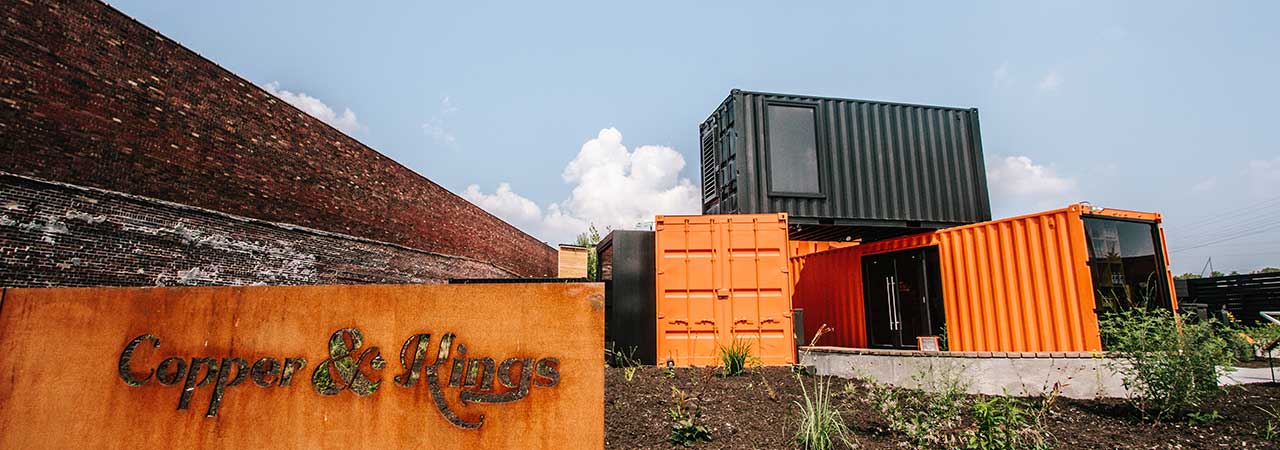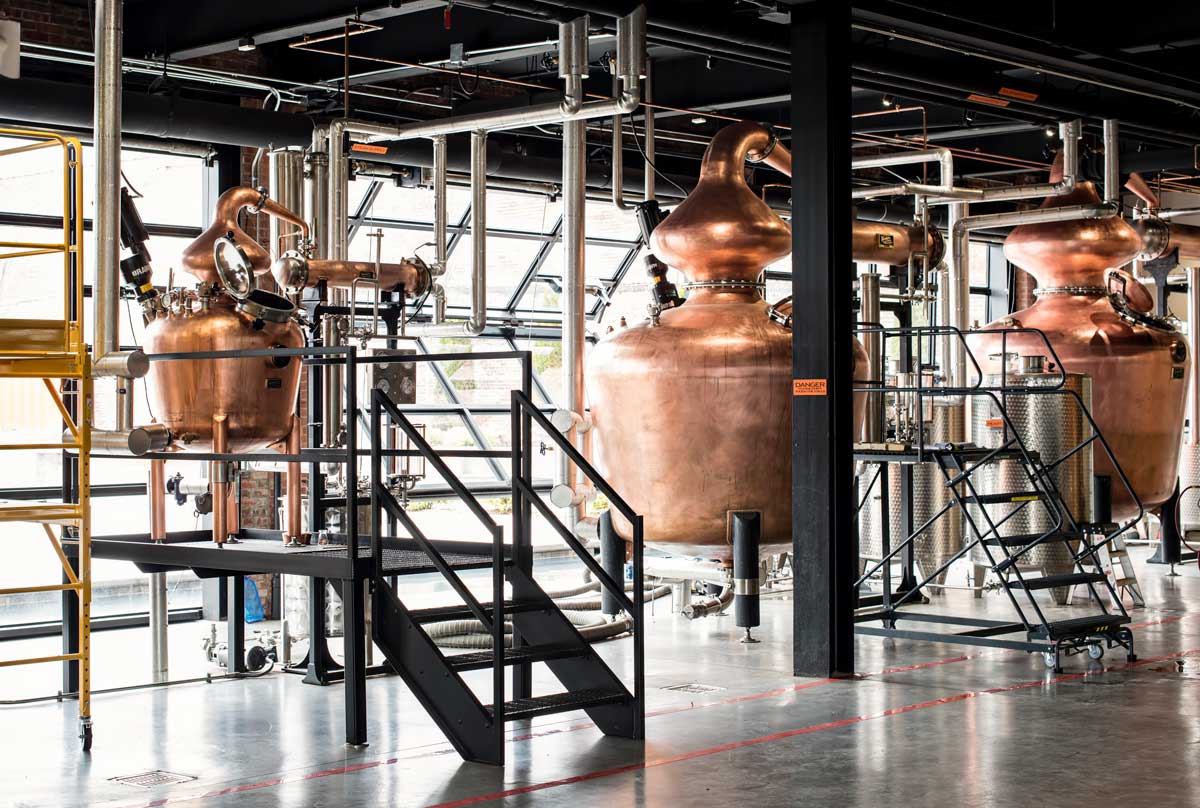Copper & Kings Distillery Tour

Today’s post is the second in a series recapping Bourbon & Banter’s 5th Anniversary Pilgrimage to Kentucky. We hope you enjoy learning a bit more about our trip and the wonderful people and places we met along the way. And of course, we’d love for you to make your own pilgrimage to Kentucky as soon as possible if you haven’t done so already. As always, thanks for being a part of our bourbon journey and spending time with us to see what we’ve got to say. Special thanks to the folks at Copper & Kings for giving us a personal tour of their wonderful facility. Cheers! ~ Pops
The second tour stop of the Bourbon & Banter 5th Anniversary Trip was the craft distiller, Copper & King (read our previous review of the distillery) . I must admit that I had not previously come across their products. Copper & Kings products include fruit brandies, specialty gins, and absinthe. Several of the brandy products feature bourbon barrel aging.
Arriving at Copper and Kings there is an impressive sense that this distillery seeks to be as much a destination, as a working distillery. You enter walking between a stack of reclaimed shipping containers. These make up their welcome center and gift shop, and into their wide-open patio, built for events. They have their three working pot stills, which are front and center, behind the 20 ft. High floor to ceiling windows at the entrance to the distillery.
As we entered the distillery, we had a little wait for our host to arrive. During this time we sampled Ginger Beer and Cream soda from a vendor of nitrogenated (not carbonated) mixers. The nitrogen process, we were told, imparts a creamier mouthfeel, rather than affecting the taste.
Making our way past the stills, we stopped at some featured barrels displayed for tasting during tours. These included several fruit brandies and gins. A few quick tastes and our host Brandon O’Daniel, Head Distiller arrived.

Brandon is a young guy and passionate about what they do at Copper & Kings. Impressively, he does not claim the title of Master Distiller as he says, “he still has a lot to learn”. After a quick viewing of the pot stills, named Isis, Magdalena, and Sara, after women from Bob Dylan songs.
Next, we made our way to the aging rooms (located in the basement). Here we found that they play music to their barrels (primarily classic rock, a lot of Credence Clearwater Revival). They told us, if you look at the liquid inside the barrel, you can see the surface ripple. This is in response to the sound of the large, refrigerator-sized, sub-woofer. It is not clear what effect this has on favor or aging time, but it is undoubtedly fun.
COPPER & KINGS DISTILLERY PHOTO GALLERY
COPPER & KINGS BACKGROUND
The following is a description of Copper & Kings in their own words:
COPPER & KINGS AMERICAN CRAFT BRANDY
We use traditional copper pot-distillation to forge untraditional craft-distilled, natural, pure pot-still brandies.
We make definitive American Brandy influenced by American Whiskey and American music. We do not make derivative brandy styled upon a European sensibility.
Our brandies are batch distilled exclusively in copper pot-stills, and are non-chill filtered, with no added sugar, boisé (powdered oak, shavings or infusion) other flavors, synthetic chemicals or caramel colorants for an uncorrupted, authentic, natural flavor, nose and color. Our aged brandies exit the barrel full integrity intact.
We adopt a “low & slow” distillation philosophy – a relatively low distillation temperature, for a longer, slower distillation, maximum copper contact, to express concentrated flavors, aromas, and smoothness.
Philosophically the art of brandy distillation revolves around the concept of retention and concentration. The distiller is attempting to retain and concentrate the nuance found in the base wine. (As opposed to whiskey distillation where the concept revolves more around extraction and purification to palatability). You “stroke” brandy in to shape.
With that said we believe that the art of brandy starts in the vineyard or orchard, and our wines are selected for superior aromatics and quality. Our focus is the distillation of unfiltered, un-sulfited wines. We are attempting to retain this essential character of the wine, the vibrancy and personality, and the better the base wine the better the brandy.
ALEMBIC BRANDY DISTILLATION
alembic-brandy-distillation
The word brandy is derived from the Dutch – “brandewijn” – “burnt wine”, a simplistic description of the boiling of wine in the distillation process.
Brandy is an agricultural spirit, distilled from (fruit) wine – fermented juice without skins, stems or residual pulp. Whiskey, in contrast, is distilled “beer” from fermented grains.
An alembic is an ancient alchemical still consisting of two connected vessels used for distillation. The modern descendant of the alembic is the copper pot-still.
The French word “Alambic” is also in common usage and Shakespearean middle-English refers to the process as “Limbeck”.
The ancient art of alembic distillation can be traced back to 3000 BC in China, 2500 BC in East India, the Greeks in 1000 BC, and the Romans in 200 BC, but rose to prominence with Persian and Arab alchemists in the 7’th and 8’th centuries. These early scientists used alembic distillation for the distillation of perfume and chemicals.
The Islamic conquering of Mediterranean Europe lead to the spread of distillation techniques and the improvement of distilling equipment across Europe by alchemists and monks. Brandy production appeared in Spain (and possibly Ireland) at the end of the 8’th century
Arnaud de Villeneuve was the first to distill brandy in France in 1250.